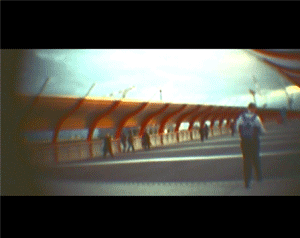
Traverse / 2003 / 4' Kings Melbourne, Australia www.projekt.com.au |
THE VIDEOTraverse About a year ago I brought a small camera from Dick Smith Electronics in Caulfield. It really is small; the unit is 1.5 cm by 1cm and the lens is 1mm in diameter. It connects to any digital video camera with an AV input and shoots in full colour. For the last few months I have been trying to conceal this camera within my clothing and have had little success. 3 weeks ago I brought a black jacket from a place called Satch on Little Collins street, which has two big button-down breast pockets. It seemed perfect for the job. I installed the unit inside the left-hand pocket with the lens shooting through one of the buttonholes. A small microphone was placed just under the pocket-flap on the other side. Two cables run down to my waist under the jacket and are clipped to my right-hand belt-loop. I always wear a grey shoulder bag, which hangs on my right hip, which is perfect for carrying a small digital camera and minidisc recorder. I cut a small hole in the back of this bag, right where it sits against the belt-loop with the cables anchored to it, so the cables can run into the bag and into the digital recording units. I have to loop the audio from the microphone through the minidisc recorder and back to the camera as it does not produce line-level. A friend helped me build a small pre-amp unit from a kitset we brought at Jcar, but it didn't work. I wanted to take it back for a refund, but couldn,t be arsed. Looping through the MD recorder only works if it has a disc inserted and is actually recording, although I found out a few days ago that if I push record and pause at the same time I will get levels. It is hard to monitor the audio on the camera as if I turn the volume up it gets feedback from the mike. The flap of the left-hand pocket has to be carefully tucked inside the pocket in order to allow the button hole to be fully exposed. Once everything is turned on I have got 90 mins recording onto miniDV tape on LP mode and as long as the battery on the MD recorder lasts if it is on standby mode. The battery on the camera lasts about 120 mins when fully charged. I had 2 batteries for the camera, but lost one on a trip to NZ recently. I forgot to mention that the small camera is powered by a 9 volt battery which also sits in the same pocket. I have to remember to unclip this when I finish recording as the battery will flatten overnight. I forgot yesterday and had to buy another battery today after missing out on a great opportunity filming an interview with my intensive-care officer at a DSS appointed job-network. She wanted me to consider job options such as hospitality and I told her that I was too busy working fulltime as an artist. I also cut the meeting short as I had lots of work to do for a show coming up soon. My intention for this project
was to spend as much time as possible over the last 3 weeks recording
with the hidden spycamera unit. The process of editing the footage
began to suggest the possibility for narratives within what seemed
to be exceedingly banal material. |
THE ARTIST
Robin Hely,
|
THE SPACE/COLLECTIVEThe Kings Artist Run Space The Kings Artist Run Space committee plans to continue its program of exciting and innovative new artwork by young and emerging artists in 2004. The young and emerging artist space will offer built in audio and video facilities and run a comprehensive curated program of group shows. offer a submission The history of The Kings Artist Run Space: In 1998 the Inner Melbourne Studio One group formed a studio complex comprising of 25 lockable artists studio in Franklin St Melbourne. They began to construct a large artist run gallery in 2001, but due to the public liability insurance costs, the new owners of the building, City Mazda, ended the lease agreement and they were forced to look for new premises. August 2002 saw the formation of The Kings Artist Run Studios in a three-story art nouveau building at 171 King Street in Melbourne. The first floor was designated as a gallery and demolition began immediately. The second floor became the Kings Artist Run Studios administered by Frank Guarino and a professional video-editing suite of five computers. Annie Wilson and Brie Trenerry have expanded the editing facilities to now include DVD authoring via an ongoing arrangement with Mission Australia and the Work for the Dole scheme. The third floor became a workshop area and access to the rooftop BBQ area and outdoor cinema in summer. In late 2002, Brendan Lee, Andrew MacKenzie, Anne Wilson and Brie Trenerry based the national arts show, Public Hangings, out of Kings and used the as yet unfinished gallery level as a film studio for the television program. As funds came available, the studio members acquired the materials and architectural support to finish construction of The Kings Artist Run Space in April 2003. The space was divided into two galleries. Gallery one is a large space with three metre high walls with two sets of track lighting, and the second gallery, a self contained video gallery with the facilitation of track lighting for non video works. May 2003 saw the first exhibition launch in the emerging artist gallery with the 3rd in a series of City of Melbourne funded PROJEKT Video Art Catalogues. These video art archives are also based in the Kings complex assisting curators and institutions get a grasp of contemporary Australian video art. |